Evening Primrose (Oenothera biennis), is a common weed, or wildflower, found throughout the northeastern and midwestern states. Other curious names include sundrop, King’s cure all and evening star, hinting at its beauty and medicinal history. It is native to North America, but was likely introduced to Europe in the 1600’s, as European settlers exported goods back to Europe.

As a biennial, the plant moves through its lifespan across two years. During the first year, a rosette of leaves forms, and the edible taproot begins to develop underground. This can then be harvested at the end of the usual growing season, in late summer. During its second year of life, the taproot becomes much too bitter, and the plant focuses all energy into sending up stems filled with cheerful, yellow flowers.
The flower petals are delicate, and lemon yellow in color, with a honey and lemon like smell. They have been a popular garden plant for centuries as word of their apparent medicinal value spread. As the blooms wither away, small fruits begin to develop, full of tiny long, edible seeds.
Edible parts and other uses
The taproot harvested during the first year of life is perfectly edible when cooked, much like a carrot or parsnip. The young leaves that form along the growing stems in the spring of the second year are also edible, and can be cooked and used as a leafy green. You can eat the flowers raw in salads and as a bright garnish for meals and desserts. Generally the part most foraged and valued for taste is the taproot.
Native Americans greatly valued the roots and leaves of evening primrose. They were cooked into many dishes, boiled in water to create tea and also used medicinally. A number of ailments were also treated, including the treatment of inflammations, weight loss and even laziness.

After its transportation to Europe, Europeans began to value its taste and apparent healing properties. They also treated skin inflammations, arthritis and some diseases which effected the nerves, including Raynaud’s Disease.
Essential oils are also extracted from evening primrose for scent and homeopathic remedies. Some scientific studies concluded that the oils may be effective in easing symptoms of eczema or nerve damage caused by diabetes. However all other ailments which many people claim it cures are questionable.
Cautions
The uncooked leaves and root could cause irritation in some people who may be sensitive to some of the compounds found within evening primrose. Although not toxic, this irritant reaction can cause discomfort in the mouth. If you are foraging evening primrose for the first time, you should test a tiny quantity first.
Because of some of the compounds evening primrose contains, it is usually advised that those with epilepsy or bleeding disorders should avoid it.
Foraging
You’ll find evening primrose growing in a number of locations. From prairies, field edges, hiking tails and in areas of disturbed soil. You may even have some growing in your own back yard.
If the plant is flowering it is best to avoid harvesting the root, as it is likely past its best fleshy and sweet flavoring. Instead, pluck some of the leaves, flower buds or seed pods and store in a sealed plastic bag to retain their moisture. Use the same as day harvesting, or keep them in the fridge for a day or two.
Loosen the earth around the taproot with a small fork and gently pull the stem right at the base of the plant. The taproot should loosen fairly easily.

Did you know…
An unusual feature of evening primrose is that it closes its flowers during the day, and opens them to the setting sun. This in turn, gave it the common name ‘evening’ primrose, and its less commonly used names ‘sundrop’ and ‘evening star’.
Conclusion
Evening primrose is a fantastic plant to start with if you are new to foraging in the midwest. It is abundant in the wild, and even a beautiful plant to grow at home in your own vegetable plot. Apart from its sunny, yellow blooms, you will also have a nutritious vegetable. It is full of protein, vitamin B3, fatty acids and betacarotene.
—————Written by Hannah Sweet
Hannah is a freelance writer and graphic designer from the UK. With a penchant for travelling, photography and all things botanical, she enjoys writing about a wealth of topics and issues, from conservation and slow living, to design and travel. Learn more about her writing and design services at www.sweetmeanders.co
Many of our readers find that subscribing to Eat The Planet is the best way to make sure they don't miss any of our valuable information about wild edibles.
See our privacy policy for more information about ads on this site







4 Responses
So dear to read your notes! I have grown this lovely plant in northern California for decades –and initially, saw how it multiplied everywhere, if I didn’t remove the seed pods. I nibble the flowers, and lightly cook leaves, and will check whether the seeds might be added to my diet (I am avoiding “lectins” these days.
I didn’t know about eating taproots only in the first year. Thank you! Delightful.
Last Mon.i had the opportunity to harvesta evening promise stand! My initial goal was to transplant it for all its benefits, but; since they’re yearlings,i tink i’ll try eatg the taproots cookd an decocted. Happily an humbly, i submit; in Jesus’s name ~sisteregina k, Bc i’m saved; he’s my elder brother an his Father is my Father.
Eat the planet~i was delighted to read Hannah Sweet’s article an enlightened by believing evening primrose benefits with much thanks to God, our creator; plus, i believe’tis true he created all things for his pleasure according to the book of Revelations 4.11!
Happily and humbly, i submit; in Jesus’s name ~sisteregina k
Typo: primrose